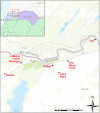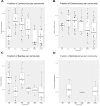Naturally Fermented Milk From Northern Senegal: Bacterial Community Composition and Probiotic Enrichment With Lactobacillus rhamnosus
- PMID: 30298060
- PMCID: PMC6160551
- DOI: 10.3389/fmicb.2018.02218
Naturally Fermented Milk From Northern Senegal: Bacterial Community Composition and Probiotic Enrichment With Lactobacillus rhamnosus
Abstract
A variety of foods fermented with lactic acid bacteria serve as dietary staples in many African communities; yet, their bacterial profiles are poorly characterized. The integration of health-promoting probiotics into naturally fermented milk products could make a profound impact on human health. Here, we characterize the bacterial community composition of a naturally fermented milk product (lait caillé) from northern Senegal, prepared in wooden bowls (lahals) with a bacterial biofilm to steer the fermentation process. We incorporated a probiotic starter culture containing the most documented probiotic strain Lactobacillus rhamnosus GG (generic strain name yoba 2012) into the local fermentation process. Bar-coded 16S rRNA amplicon sequencing of lait caillé samples indicated that the bacterial community of lait caillé has high species richness with over 100 bacterial genera; however, few have high abundance. In contrast to the diverse bacterial compositions of other characterized naturally fermented milk products, the composition of lait caillé predominantly consists of the lactic acid bacteria Streptococcus and Lactobacillus, resembling the bacterial composition in regular yogurt. The bacterial community composition of lait caillé varies geographically based on the presence of some genera, including Lactoccoccus, Enterococcus, Bifidobacterium, and Bacillus, but this trend is not consistent within production communities. The diversity of bacterial communities is much higher in the lahal biofilm than in the naturally fermented milk products, which is in turn greater than in commercial yogurts. Addition of a starter culture with L. rhamnosus yoba 2012 to milk in lahals led to substantial growth of this probiotic bacterium during the fermentation process. Two independent quantitative PCR-analyses specific for L. rhamnosus yoba 2012 indicated a 20- to 60-fold increase in the total number of probiotic bacteria in the first batch after inoculation. A similar increase of the probiotic was observed in a variation of lait caillé prepared with carbohydrate-rich millet granules (thiakry) added prior to fermentation. This study shows the feasibility of integrating health-promoting probiotic strains into naturally fermented foods produced in regions with a high prevalence of malnutrition.
Keywords: Lactobacillus rhamnosus GG; Lactobacillus rhamnosus yoba 2012; bacterial community; lait caillé; naturally fermented milk; probiotics.
Figures






References
-
- Agence Nationale de la Statistique et de la Démographie [ANSD], ICF (2017). Sénégal. Enquête Démographique et de Santé Continue (EDS Continue 2016). Rockville, MD: ANSD and ICF.
LinkOut - more resources
Full Text Sources

